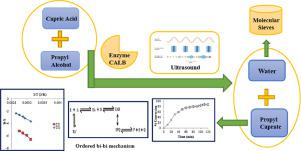Chemical Engineering and Processing: Process Intensification ( IF 3.8 ) Pub Date : 2021-09-15 , DOI: 10.1016/j.cep.2021.108633 Dhara T. Parikh , Kavita J. Lanjekar , Virendra K. Rathod

|
The present work evaluates the influence of ultrasound on lipase-catalyzed esterification for the synthesis of propyl caprate in a solvent-free system. The optimum conditions were found as molar ratio of capric acid: 1-propyl alcohol 1:3, catalyst loading 1% (w/w), molecular sieves loading 5% (w/w), temperature 60 °C, agitation speed 100 rpm, sonication frequency 22 kHz, duty cycle 80% (10 min) and ultrasound power 100 W yielding 86.86% conversion of capric acid. Compared to conventional agitation, ultrasound technology significantly improved process productivity to around 3% more acid conversion for each batch with 50% less requirement of catalyst amount and 5 fold less reaction time with enhanced enzyme recycling up to 9 cycles and stability. The activation energy requirement was lower (6.22 kcal/mol) with ultrasound than the conventional approach (9.028 kcal/mol). Furthermore, the esterification process was observed to be endothermic and spontaneous, with enthalpy (ΔH), entropy (ΔS), and the Gibbs free energy change (ΔG) values of 83.66 kJ/mol, 250.23 J/mol/K, and -2.74 kJ/mol, respectively. An ordered bi−bi mechanism involving the dead-end complex formation with lipase and inhibition of the reaction by capric acid was presented. Ultrasound application was found to be an influential tool to enhance the performance of biocatalyst in this esterification reaction.
中文翻译:

超声辅助脂肪酶催化合成癸酸丙酯:工艺优化、动力学和热力学评估
目前的工作评估了超声对脂肪酶催化酯化的影响,用于在无溶剂系统中合成癸酸丙酯。最佳条件为癸酸:1-丙醇摩尔比1:3,催化剂负载1%(w/w),分子筛负载5%(w/w),温度60℃,搅拌速度100rpm ,超声处理频率 22 kHz,占空比 80%(10 分钟)和超声功率 100 W,产生 86.86% 的癸酸转化率。与传统搅拌相比,超声波技术显着提高了工艺生产率,每批酸转化率提高约 3%,催化剂用量减少 50%,反应时间减少 5 倍,酶回收率提高至 9 个循环和稳定性。活化能要求较低 (6. 22 kcal/mol) 与超声比传统方法 (9.028 kcal/mol)。此外,观察到酯化过程是吸热和自发的,焓 (ΔH)、熵 (ΔS) 和吉布斯自由能变化 (ΔG) 值为 83.66 kJ/mol、250.23 J/mol/K 和 -2.74千焦/摩尔,分别。提出了一种有序的 bi-bi 机制,涉及与脂肪酶形成死端复合物和癸酸对反应的抑制。超声应用被发现是一种有影响力的工具,可以提高生物催化剂在该酯化反应中的性能。提出了一种有序的 bi-bi 机制,涉及与脂肪酶形成死端复合物和癸酸对反应的抑制。超声应用被发现是一种有影响力的工具,可以提高生物催化剂在该酯化反应中的性能。提出了一种有序的 bi-bi 机制,涉及与脂肪酶形成死端复合物和癸酸对反应的抑制。超声应用被发现是一种有影响力的工具,可以提高生物催化剂在该酯化反应中的性能。











































 京公网安备 11010802027423号
京公网安备 11010802027423号